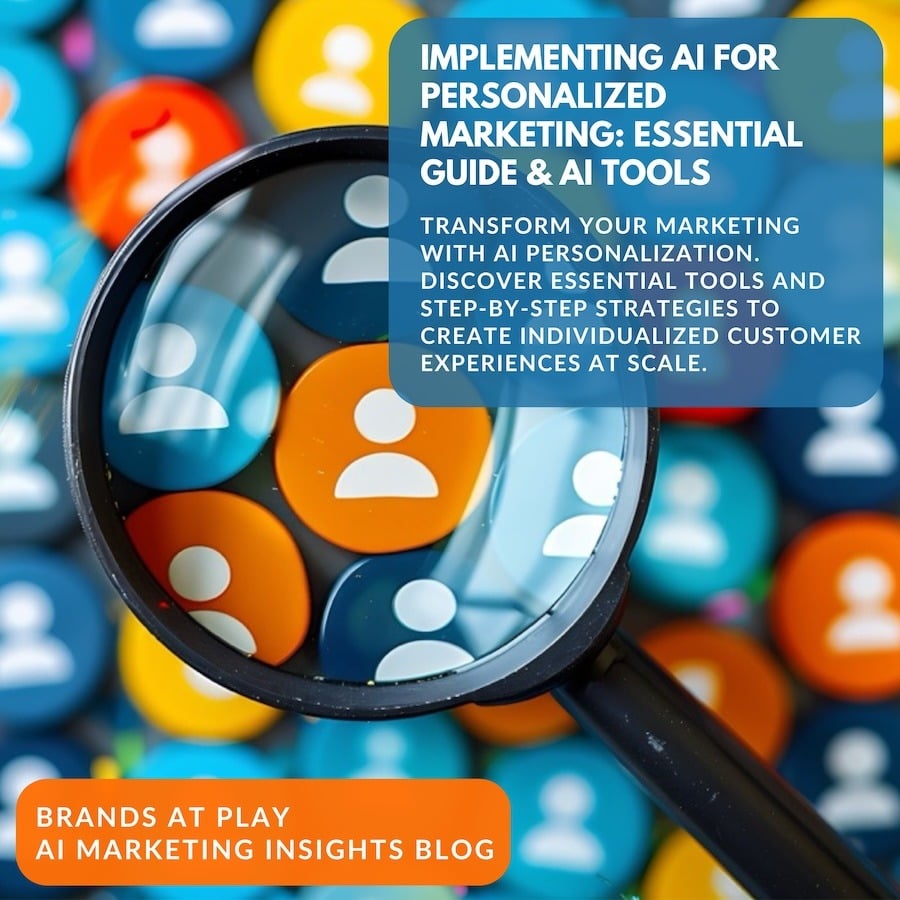Small Business Digital Marketing Strategies: The Playbook for Growth
Small businesses are rewriting the rules of marketing. With tighter budgets, leaner teams, and more competition than ever, success comes down to one...
5 min read
Stephanie Unterweger : Feb 27, 2025 5:30:00 PM

As we venture into 2025, the transformative potential of artificial intelligence (AI) continues to gain momentum, especially in enhancing productivity. As businesses and professionals seek innovative ways to maximize their output, understanding how AI tools can effectively streamline processes and improve overall performance has never been more critical. In this article, we will explore the role of AI in productivity, examine top tools for 2025, and provide guidance on selecting the right tools to fit your needs.
The integration of AI technologies into daily workflows has surfaced as a game changer across various industries. AI is not merely a tool for automation; instead, it creates a synthesis where technology and human effort collaborate, enhancing productivity on multiple fronts.
AI drives productivity by taking on repetitive tasks, thereby freeing up valuable time for employees to focus on strategic and creative endeavors.
According to a study by McKinsey, organizations that effectively use AI can improve productivity by up to 40% by automating decision-making processes and repeatable tasks.
AI tools provide an unbiased analysis to analyze vast data sets and uncover insights that would be impossible for humans to generate quickly, thus accelerating the pace of decision-making and innovation. For example, in the marketing sector, AI can sift through consumer behavior data to identify trends and preferences, allowing companies to tailor their campaigns more effectively and efficiently. This enhances customer engagement and maximizes the return on investment for marketing efforts.
AI-powered productivity tools enhance work efficiency by optimizing workflows and streamlining operations. As businesses adopt AI-driven applications, they experience reductions in operational costs and time spent on mundane tasks. For instance, AI-based chatbots can manage customer inquiries 24/7, ensuring immediate responses and alleviating the burden on customer service agents.
Furthermore, AI algorithms enable real-time project updates and resource management, which lead to better team collaboration and more timely execution of tasks. In fields such as manufacturing, AI can predict equipment failures before they occur, allowing for proactive maintenance that minimizes downtime and maximizes productivity. This predictive capability not only saves costs but also enhances the overall reliability of operations, fostering a culture of continuous improvement within organizations.
Additionally, the use of AI in data analysis goes beyond just operational efficiency; it empowers organizations to make informed strategic decisions. By leveraging machine learning models, companies can forecast market trends and consumer demands with greater accuracy, enabling them to adapt their strategies swiftly. This agility is crucial in today’s fast-paced business environment, where the ability to pivot quickly can be the difference between success and failure.

With a plethora of AI tools available, identifying the right ones for your workflow can substantially enhance your productivity. Here we take a look at some leading AI tools expected to make waves in 2025.
Time management is crucial for maintaining productivity levels, and AI offers various tools that help individuals and teams manage their schedules more effectively. Applications like Clockify and RescueTime use AI to track time spent on tasks and provide insights on productivity patterns, enabling users to eliminate time-wasting habits.
Additionally, tools like Motion leverage AI to intelligently schedule tasks based on deadlines and priorities, ensuring optimal time usage without the chaos of manual planning. These applications can analyze your work habits and suggest the best times for deep focus sessions, breaks, and even collaborative work, making them invaluable for anyone looking to maximize their efficiency.
Automation is key to boosting productivity, and AI tools such as Zapier, Workato, and IFTTT Evolutions empower users to design automated workflows between applications. By seamlessly connecting various software systems, these platforms facilitate automatic data transfers and execute tasks without human intervention. This not only conserves valuable time but also minimizes the risk of errors, as automated processes perform consistently and accurately compared to manual efforts.
The latest generation of AI tools incorporates natural language processing capabilities, enabling users to configure automation using simple conversational commands. This makes the technology accessible even to those who aren’t tech-savvy.
Some of our favorite project management tools, Trello and Asana, have incorporated AI to improve progress tracking and collaboration efficiency with teams. These tools can predict project outcomes based on historical data and provide recommendations on task prioritization and team assignments.
The integration of AI means project managers can make informed adjustments proactively, leading to smoother workflows and timely project completions. Additionally, AI-driven analytics can provide real-time feedback on team performance, allowing leaders to identify bottlenecks and redistribute workloads as necessary, ensuring that projects remain on track and within budget.
Some advanced project management tools now feature AI chatbots that facilitate communication among team members, answering queries and providing updates seamlessly. This fosters better collaboration and ensures that everyone stays aligned with project goals, further enhancing overall productivity.

Implementing AI tools offers several significant advantages that can reshape any organization's productivity landscape. These benefits include increased efficiency, improved accuracy, and enhanced decision-making.
With AI automating routine tasks, employees can devote more time to higher-level responsibilities. This transition not only boosts individual productivity but also enhances overall organizational output. A recent report from Deloitte highlighted that companies using AI tools saw an improvement in efficiency metrics as high as 27%.
The ability to optimize workflows and reduce delays ensures that teams can focus their efforts where they matter most. For example, AI can streamline communication channels by managing emails and scheduling meetings, allowing employees to spend less time on administrative tasks and more on creative problem-solving and collaboration. This shift not only fosters a more engaged workforce but also cultivates an environment where innovation can thrive, as team members are empowered to think critically and explore new ideas without the burden of mundane tasks weighing them down.
AI-driven tools often outperform human capabilities in terms of accuracy and precision, especially in data processing and analytical tasks. By minimizing human error, organizations can rely on AI-generated insights for critical decision-making, increasing the quality of outcomes.
Additionally, AI-enabled tools continuously learn from ongoing data inputs, further refining their accuracy over time. This adaptive learning process means that as more data becomes available, the AI systems can identify patterns and anomalies that may not be immediately obvious to human analysts. Such capabilities are particularly beneficial in sectors like finance and healthcare, where precision is paramount.
By leveraging AI, organizations can not only enhance their operational accuracy but also gain deeper insights into their processes, leading to more informed strategic planning and resource allocation.

The data-driven insights provided by AI tools empower managers and executives to make informed decisions swiftly. Advanced analytics and predictive modeling enable organizations to anticipate trends and challenges before they arise, creating a competitive advantage.
Additionally, AI can facilitate scenario planning, allowing organizations to assess various strategies and their potential impact on productivity. By simulating different business environments and outcomes, leaders can better understand the risks and benefits associated with each decision. This proactive approach not only minimizes uncertainty but also fosters a culture of agility within the organization, where teams are prepared to pivot and adapt to changing circumstances.
Furthermore, the integration of AI into decision-making processes can enhance collaboration across departments, as stakeholders can access shared insights and analytics, leading to more cohesive and aligned strategies that drive the organization forward.

With various options available, selecting the appropriate AI tool requires careful assessment and consideration. It is critical to align AI capabilities with the specific requirements of your business.
Begin by evaluating your current productivity challenges. Are you struggling with time management, or is task automation the primary concern? Understanding your specific pain points will make it easier to choose tools that directly address those needs.
Engaging with teams to discuss their workflow hurdles can also provide greater clarity on which features of AI tools will have the most significant impact.
Examine the features of selected AI tools to ensure they align with your operational processes. Look for tools that offer customization options, integrations with existing software, and user-friendly interfaces. Going through case studies and reviews from other companies can provide valuable insights into each tool’s efficacy.
It may also be beneficial to request demonstrations or trial versions to understand how the tools can fit into your organization's workflow seamlessly.

Budget considerations are crucial when deciding on AI tools. Analyze the return on investment (ROI) potential, factoring in both direct savings from automation and any cost reductions achieved through improved productivity. Tools that enhance efficiency often pay for themselves within a short period.
Don't hesitate to reach out to AI marketing agencies, such as Brands at Play, to assist you in developing a comprehensive AI marketing strategy tailored to your organization’s specific goals and budget.
As 2025 unfolds, embracing AI tools can elevate productivity across all sectors. The right approach is essential for organizations looking to capitalize on the benefits of AI. Don't miss out on the opportunity to enhance your workflow and results.

For assistance in crafting a bespoke AI strategy that caters to your unique operational needs, contact Cleveland-based AI Marketing agency, Brands at Play or schedule your complimentary AI Marketing Strategy Session today!

Small businesses are rewriting the rules of marketing. With tighter budgets, leaner teams, and more competition than ever, success comes down to one...

12 min read
Introduction to AI Marketing Automation According to HubSpot, a robust marketing strategy is the cornerstone of any successful business...

According to Salesforce's State of the Connected Customer Report, 73% of consumers expect companies to understand their unique needs and...